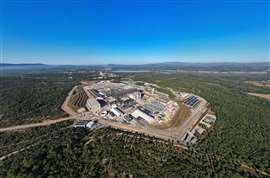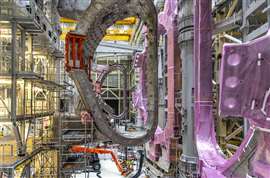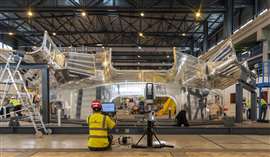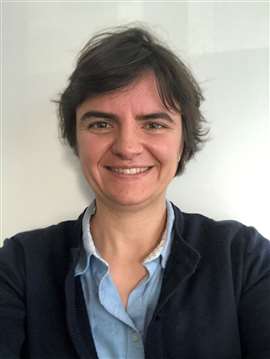ITER: Where science and construction meet the future
20 February 2024
A eureka moment is on the horizon, for science and for global energy.
 An aerial view of the 180 hectare site of the International Thermonuclear Experimental Reactor (ITER) project Photo: ITER
An aerial view of the 180 hectare site of the International Thermonuclear Experimental Reactor (ITER) project Photo: ITER
Before that happens, however, a large and complex construction project must be completed and, like most mega-projects, it is over budget and delayed.
The project is ITER (the International Thermonuclear Experimental Reactor) and it is being built in Provence in southeastern France. Construction on the project began in 2010, with an estimated completion date of 2018. Now, it is unlikely that the reactor will be operational before 2030.
The roots of ITER, however, go much further back. Given today’s geopolitical situation, it seems hard to believe that it was jointly brought to life in 1986, by US President Ronald Reagan and Soviet General Secretary Mikhail Gorbachev.
The pair said the project should be delivered “…for the benefit of all mankind”. If it ultimately succeeds in its mission to deliver a tenfold return on power input (ie 500MW of fusion power output from 50MW of input heating power), it will have proven fusion’s potential to completely revolutionise the global energy landscape.
ITER today
Visiting the ITER project is a very different experience to taking a tour of a more traditional nuclear power plant.
It’s not so much the new science that leaps out at you – although the science is without doubt at the most cutting of edges – but rather the sense of the facility being a global village.
It’s certainly an example of how national borders can be overcome. The facility’s open-plan offices, corridors and cafeterias buzz with the sound of scientists from around the world discussing best practices and next steps for the delivery of energy from nuclear fusion.
What’s more, the ITER footprint is big – spanning a 180 hectare site – which makes it hard to process the fact that this is merely an experimental facility. It certainly feels as though something world-changing is happening here.
The tokamak
 Vacuum vessel bevel repair will be carried out at the ITER site by a consortium called SIMANN comprising the Italian firms SIMIC and Ansaldo Nucleare Photo: ITER
Vacuum vessel bevel repair will be carried out at the ITER site by a consortium called SIMANN comprising the Italian firms SIMIC and Ansaldo Nucleare Photo: ITER
At the heart of ITER is the tokamak reactor, which will play host to the same fusion reactions that take place at the centre of the sun.
The reactor will use incredibly large magnets to confine superheated spinning plasma.
The plasma will reach a mind-boggling 150 million degrees Celsius (at least ten times hotter than the sun) and, as it spins, the deuterium and tritium atoms within it will collide, causing their nuclei to fuse together.
The energy created from this fusion is far greater than the splitting of atoms, which takes place in today’s nuclear reactors.
Another benefit of fusion is that it’s far cleaner than fission and far less dangerous. While the process does create radioactive waste, it has a hazardous half-life of only 12.3 years.
From a safety perspective, reactions within the tokamak rely on the continuous input of fuel, so if for some reason the power input is withdrawn, the machine simply ‘switches off’.
The purpose of the project, of course, is to prove the science at scale and only once that is done can work begin on establishing nuclear fusion as a realistic power source for the future.
And there, as they say, is the rub.
As ITER’s communication officer, Sabina Griffith, says, “Size matters in fusion. You need to have a certain volume; an amount of molecules and atoms in there [the Tokamak], to have enough reactions to create a lot of electricity and heat.
“ITER is the project that has to prove that we can do it on an industrial scale.”
Put simply, the goal of ITER is to generate 500MW of thermal output for one hour.
Once that is achieved, the race will truly be on – around the world – to change the face of global energy and possibly help bring the planet back from the brink of a climate catastrophe.
Not always plain sailing
The nature of ITER’s set-up should mean there is no need to generate international excitement about nuclear fusion – 35 nations are already emotionally (and financially) invested.
Unfortunately, while ITER is a tremendous global collaboration, its egalitarian set-up may at times have hampered its progress.
Checks and balances, for example, take time in both the undertaking and the ratifying – especially when precision components are being manufactured in so many different countries.
The challenges of the construction process were somewhat exposed during the Covid pandemic, when it became exponentially more difficult to send scientists and engineers around the world to carry out quality checks.
Late in 2022, it was announced that defects had been detected in the thermal shields that were manufactured during Covid. These shields will insulate the super-cold superconducting magnets from the super-hot plasma inside the tokamak.
 Metrology is involved in every step of ITER machine assembly, including the repair works underway on critical components. The size of thermal shield segments, measuring around 15 metres by 10 metres in area, is one of the challenges for metrologists, obliging them to take laser observations from multiple instrument locations. Photo: ITER
Metrology is involved in every step of ITER machine assembly, including the repair works underway on critical components. The size of thermal shield segments, measuring around 15 metres by 10 metres in area, is one of the challenges for metrologists, obliging them to take laser observations from multiple instrument locations. Photo: ITER
Cracks in thermal piping were found; cracks so small they had to be identified using X-ray tomography, which was developed in collaboration with research engineers at CERN in Switzerland.
Ultimately, some 23km of piping has had to be replaced. ITER bosses warned that consequences “would not be insignificant”, and the full ramifications in terms of ITER’s delivery are still unknown.
Building the sun on earth
The good news is that challenges and setbacks are, up to a point, one of the benefits of ITER as an experimental reactor.
At the time, the director general of ITER, Pietro Barabaschi, said, “The know-how we are acquiring in dealing with ITER’s first-of-a-kind components will serve others when they launch their own fusion ventures.”
It’s also fair to say that, when a project involves the installation of more than a million components, there are going to be one or two bumps in the road.
ITER’s communication officer, Sabina Griffith has also had to explain, on numerous occasions, why it is taking so long to build the reactor.
She says, “These are first-of-a-kind components; nobody has done this before.
“We are really playing with mother nature’s forces, so we have to do everything with the greatest care.”
Alongside the attention to detail required to ensure the success of ITER, of course, there are the logistical issues that come with any such multinational project.
Components are constantly arriving at ITER from all over the world – and Griffith describes one component in particular that must be handled with the utmost care.
“The central solenoid, which is the big magnet at the centre of the machine, will be made of six modules; three are already here, with three more still to come,” she says.
“The superconductor is coming from Japan; it will be shipped to San Diego, to General Atomics, and they will turn it into the magnet.”
Griffith concludes, “This is going to be the strongest magnet mankind has ever built. With a [magnetic field] strength of more than 12 Tesla.
“It has the stored energy to lift two aircraft carriers…It should be bolted together very carefully.”
To the untrained ear, that might sound like something of an understatement.
Next-level precision
One of the engineers who will be responsible for overseeing much of the ‘bolting together’ of ITER is Laure Navarro.
Since she joined the project – some 3 months before Covid lockdowns began to roll out across Europe – she says the construction learning curve has been steep, to say the least.
“Sometimes we have tolerances of less than 1cm to place a massive component,” she says. “These are things that require metrology and we have a lot of metrology experts at ITER.
“So, the positioning of things in space is very precise and a lot of technology is required to integrate everything.”
As Griffith stated, there are many never-before-seen components within the ITER build. Many of these will bring unique lifting and manoeuvring challenges, not just because they are large and heavy, but through their unorthodox centres of gravity.
Navarro says, “The biggest single element we put in the tokamak was a lift in 2020… it was 1250 tonnes, in one piece.
“We have massive 1500 tonne overhead cranes in the assembly hall. These are the ones lifting and travelling with the biggest components.
“We learned a lot the first time we used the crane with a real component…about its capabilities, in terms of accuracy and speed and what to expect as a standard duration for a lift.
“That first lift was actually 20 hours in total, so it helped a lot with our understanding of how the crane reacts.
Tools for the job
“On the sector module lift, which was not so heavy but critical, it was also very interesting, because you have two centres of gravity [on the component], so you need to be able to monitor the gaps between the two shells and integrate them.
“For sure, every time you learn.”
Navarro adds, “We and the contractors have developed tools specifically made for the purpose of ITER construction. In fact, we have more purpose-built tools than regular tools for the assembly of the tokamak.”
Describing the machine as “like giant Lego,” Navarro plays down the engineering challenges of moving huge components into positions with critical accuracy.
“We have plenty of mobilisation tools in 3D to show us how we need to assemble it,” she says.
“We use laser scanners that help position with targets, and we have sensors to measure gaps.”
She adds, however, that, “Having a colourful 3D video is nice, but when you see the components in reality and you have to move them around, this is something else.
“Sometimes it’s more hands-on pragmatic experience that works – sometimes just having a vertical line, with gravity is sufficient.”
It’s good to know that, even when humans are attempting to build a new sun, there is room for a plumb line.
We have to hope that there are no more major bumps in the road for ITER and that it proves the science of fusion for power.
It will be the first reactor to produce more heat than is input and could lead the way to safe, clean energy for thousands, if not millions of years.
|
ITER at the Construction Technology Summit 2024  Nuclear engineer, Laure Navarro. Photo: ITER Nuclear engineer, Laure Navarro. Photo: ITER
Laure Navarro, the nuclear engineer quoted in this article, will be speaking at the Construction Technology Summit, to be held in Austin, Texas on March 19. She will offer views on the science taking place at ITER, as well as the cutting-edge construction technology being used to install over a million components at the facility. To register for the event, visit www.ct-summit.com |
Brought To You By
|
STAY CONNECTED



Receive the information you need when you need it through our world-leading magazines, newsletters and daily briefings.
CONNECT WITH THE TEAM








